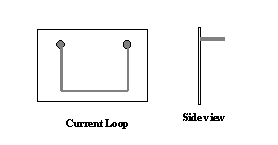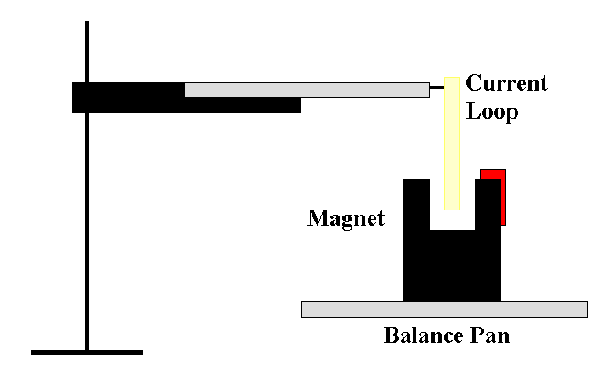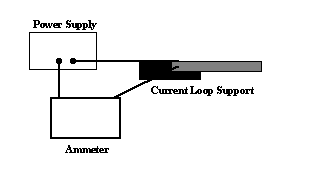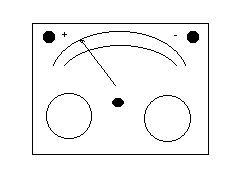

 PYL 106: Lorenz
PYL 106: Lorenz 



Lorentz Force Law F= I L ´ B
We discussed in the lab on drawing electric field lines, how force is related
to electric field. If a particle has a charge q0 and is in an
electric field E, then it experiences a force F which is
proportional to both the charge and the electric field and is in the same
direction as the electric field.
The case of a magnetic field is a bit more complicated. For a particle in a
magnetic field to experience a force, the particle must have a charge and must
be moving (i.e. have a velocity). If the velocity v and the magnetic
field B are in the same direction (parallel), there is no force. More
generally, the magnitude of the force is proportional to the magnitude of the
velocity, the magnitude of the magnetic field and the sine of the angle between
them. The direction of the force is perpendicular to the plane in which the
other two vectors (v and B) lie. Putting it all together yields
F= q0 v ´
B
If you have a bunch of charged particles moving, it is known as a current. In
such a case, the equation above can be rewritten as
F= I L ´ B
where I is the current and L is the length of the wire. Verify that
q0v and IL have the same dimensions.
Part I
- Attach the current arm (see figure below) to a ringstand.

- Insert a current loop (see figure below) into the end of the current arm.
You will find holes on the ends of the current arm. (Use only the ones
labeled SF 37-40.)

- Record the horizontal length of the loop. Why only the horizontal?
- Place the magnet on the pan balance and find its mass to the nearest tenth
of a gram. The effects we are looking for are small, try to measure the mass
carefully.
- Set up the current arm such that the bottom part of the current loop in
passing through the magnet (which is still on the pan balance). Make sure it
is not touching the magnet. (See figure below.)

- Connect the current arm (you will find holes on top of it) and an ammeter
(in series, of course) to a power supply. (See figure below.) Make sure the
power supply is on DC. If you find your power supply isn't working, try
pressing the (circuit breaker) button in the back.

Ammeter:
We are not using the Simpson multimeters.
Instead we are using the older looking ammeter shown in the figure below.

Ammeters measure current. You will see several settings on your ammeter. One
setting tells the meter to expect DC currents. Another setting tells the meter
the maximum current you expect to be reading. Set it at 10 A. A needle
points to a number between 0 and 100 telling you what percentage of your maximum
current is going through the ammeter. Notice the mirror behind the needle. It
tells you when you are looking straight on - when you see just one needle, not
the needle at its reflection. Turn your power supply off and make sure the
needle on your ammeter is at zero. That little screw head is what you use to
adjust the needle. The ammeters were meant to lie flat, not sit up on their
edge.
Measurements I
- Send a current of 1 amp through the circuit.
- The pan balance should no longer be balanced. Why? (Hint: it
involvesF= I L ´ B and Newton's
Third Law.)
- Adjust the balance and find the magnitude of the additional force.
- Repeat for I=2,3,4 and 5 amps.
- Plot F versus I. Fit to a straight line. What is the slope? (Not the
number but what is it physically.)
- Extract B. What are its units?
Length =
| Current |
Change in mass
(sign included) |
Force |
| |
|
|
| |
|
|
| |
|
|
| |
|
|
| |
|
|
Measurements II
- Reverse the leads in the the current arm and repeat the above measurements
and plotting. Reversing the current should this change the direction of the
current.
Length =
| Current |
Change in mass
(sign included) |
Force |
| |
|
|
| |
|
|
| |
|
|
| |
|
|
| |
|
|
- Make a note of which way the current is flowing through the horizontal
part of the circuit element. Also note the orientation of the magnet (which
color is on which side). Make a drawing. This drawing must appear in your
report.
- For this drawing determine the direction of the Lorentz force.
- Determine the direction of the magnetic field using the right-hand rule.
Measurements III
- Replace the current loop used above and find the additional force for I=2
amp.
- Repeat for a total of four lengths (SF 37, 38, 39 and 40).
- Plot F versus L. Fit to a straight line. What is the slope? Physically,
not just a number.
- Extract B. How does it compare to the result above?
Current =
| Length |
Change in mass |
Force |
| |
|
|
| |
|
|
| |
|
|
| |
|
|
| |
|
|



 PYL 106: Lorenz
PYL 106: Lorenz 








